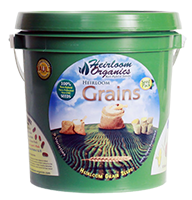|
Home > Guides > Grains > Millet |
|
How to Grow Millet | Guide to Growing Millet |
|
|
|
|
| |
 |
|
Overview |
|
|
|
|
|
| |
|
| |
The millets are a group of small-seeded species of cereal crops or grains, widely grown around the world for food and fodder. They do not form a taxonomic group, but rather a functional or agronomic one. Their essential similarities are that they are small-seeded grasses grown in difficult production environments such as those at risk of drought. They have been in cultivation in East Asia for the last 10,000 years.
“Millet” is a name that has been applied to several different annual summer grasses used for hay, pasture, silage and grain. The millets most commonly cultivated in Kentucky, pearl millet and foxtail millet, are grown primarily as a forage for temporary pasture. If properly managed they can provide high yields of good quality forage in a short period, without the risk of prussic acid poisoning.
Pearl millet is higher yielding than foxtail millet and regrows after harvest if sufficient stubble is left. Dwarf varieties, which are leafier and more suited for grazing, are also available.
Foxtail millet is a lower-yielding grass that will not regrow to produce another harvest. Because it is shorter and finer-stemmed, it is easier to harvest as hay. It can serve as a good smother crop to be used before no-till seeding of other crops, such as fescue or alfalfa. Foxtail millet is also used as a wildlife planting to produce food
and cover for various wild birds.
Growing grains is easy and fun! Buy heirloom grain seeds here and start today! See our complete grain growing guide here. Did you know that most grains can be sprouted for high-nutrient super-foods? Try our sprouts packs here with the 3-Day Independence Sprouts Pack. Getting cabin fever? Can't wait to get to that Spring gardening? Grow indoors right now with the Complete Micro Greens Growing Kit or the Micro Greens Seed Pack. Have a high nutrient vegetable garden on your windowsill this week! |
|
| |
|
|
| |
Growing Guide
GROWING NOTES
Millet is one of many seed grasses that can be used as a food source. The grain, similar in nutrient composition to corn, is richer in protein and fiber. Millet has been cultivated for thousands of years and is believed to be one of the first grains harvested by humans for food. Millet prefers hot, extended summers and does well growing in the southern states below the Mason-Dixon line.
Prepare the plot for planting. Work in organic compost or a nitrogen-rich fertilizer.
Plant the seed, spacing each individual seed approximately 2 inches apart. Make your rows at least 1 foot apart. Cover with at least 1 inch of soil.
Add additional compost to the plot as the millet grows. Like corn, millet draws a lot of nitrogen from the soil.
Mulch the plot with straw or other covering if desired. This can help the soil retain water and cut down on pests.
Harvest the millet when the grasses and seed heads have turned golden brown. Millet can be harvested either by hand or with the use of a mechanical thresher.
Tips & Warnings
Millet was first brought to the United States in 1874 and first planted in Southern California. Millet grains were found entombed with the pharaohs of Egypt. Millet is a classed as grain sorghum and is a popular ingredient in birdseed. Millet can be planted in any soil that can produce corn. Millet is being studied as a possible source for ethanol production. Millet can be cooked as porridge, a side dish similar to rice or ground to make flour or meal.
MAINTAINING
Normal average rainfall should take care of watering requirements to enable the grass to reach optimum growth. In the meantime, as the grass grows, it attracts more wildlife with the cover it affords.
|
|
| |
|
| |
Heirloom seeds are the gardeners choice for seed-saving from year-to-year. Learning to save seeds is easy and fun with these books. Before you harvest, consider which varieties you might want to save seeds from so that your harvesting practice includes plants chosen for seed saving. Be sure to check out our newest seed packs, available now from Heirloom Organics. The Super Food Garden is the most nutrient dense garden you can build and everything you need is right here in one pack. The Genesis Garden s a very popular Bible Garden collection. The Three Sisters Garden was the first example of companion planting in Native American culture. See all of our brand-new seed pack offerings in our store.
|
|
| |
|
|
| |
Harvesting Guide
HARVESTING
Harvest the millet when the grasses and seed heads have turned golden brown. Millet can be harvested either by hand or with the use of a mechanical thresher.
SAVING SEEDS
To save seeds cut the mature seed cluster from the stem....the mature seeds will be swollen and release easily from the cluster by simple rubbing. They are very small, roundish with pointed ends and light wheat color. Allow the seed head to dry for a few days to facilitate easy removal of the seeds. Once the seeds are released from the stem allow them to dry for a few more days before packing.
|
|
| |
|
|
|
| |
|
|
|
|
|
| You can find this variety in the following Seed Packs: |
|
  |
|
| Click the packs below to see some of our other wonderful products |
|
|
|
|
|
|
|